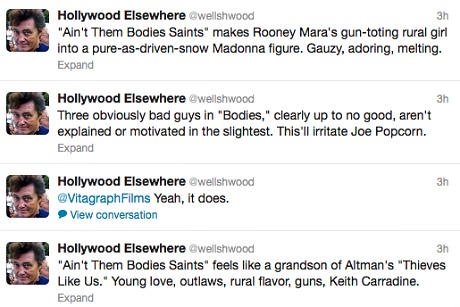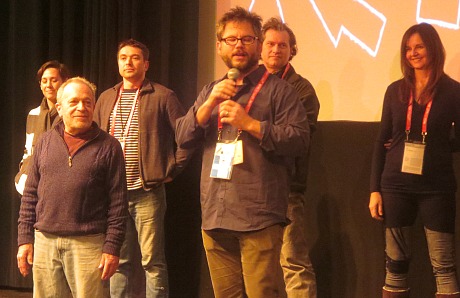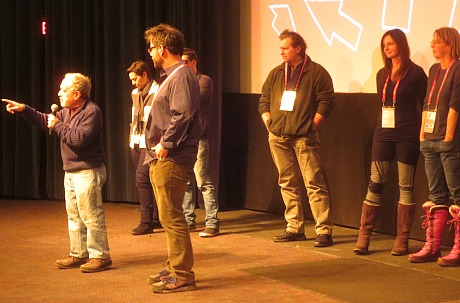For the sin of creative absorption — getting caught up in writing a piece as I sat in the Yarrow Hotel and therefore not rushing over to the Holiday Cinemas cattle tent early enough — I can’t see the 2:30 pm press & industry screening of Ryan Coogler‘s Fruitvale…no room at the inn. And the only chance I have to see it again is late Thursday afternoon, which conflicts with Escape From Tomorrow. Terrific — I’ll flip a coin. The Weinstein Co. has bought distrib rights for $2.5 million.
 Jeffrey Wells
Jeffrey Wells
Four Movies…Okay, Five
In my book Michael Winner, the British director who has died at age 77, was in a good groove as an effective, second-rate action-thriller director from 1972 to ’74, during which time he directed The Mechanic (’72), Scorpio (’73), The Stone Killer (’73) and his semi-mastepiece, Death Wish (’74). There was also the entirely respectable The Nightcomers (’72) with Marlon Brando as Quint.
A Little Escape Action
Nobody and I mean nobody is better than yours truly at missing out on small Sundance buzz films. Just as they’re just starting to break out and be talked about, I mean. I am a stone friggin’ genius at not being in the midst of the early chatter, much less the forefront. Take Randy Moore‘s Escape From Tomorrow, which I missed last Friday evening because I decided to see Don Jon’s Addiction instead and which I missed late Saturday night because I don’t see movies at 11:30 pm, period.

From Randy Moore’s Escape From Tomorrow.
But I’ll catch it it at the Library on Thursday at 5:30 pm…okay? Even if that’s not okay it’ll have to do.
I have a queer little equation that I carry around while covering this festival. The more excited that brilliant, impassioned but sometimes off-on-their-own-orbit critics get about a quirky Sundance film, the less likely Joe Popcorn is going to even hear about it much less see it, if and when it gets commercially released.
And Escape From Tomorrow’s commercial prospects are apparently in doubt, says L.A. Times guy Steven Zeitchick, because it casts a dark, mournful shadow on the Disney Theme Park experience. But maybe (who knows?) it’ll become “one of those films” that everyone wants/needs to see. Or maybe it’ll play a week at the Nuart.
I honestly think it’s different when guys like myself go apeshit over a film. Then it has a chance because I listen to my anti-intellectual instincts, I don’t get all caught up in my own swizzle-stick obsessions, and because my feet are planted squarely on the pavement.
Here’s a key passage from Zeitchik’s 1.19 piece:
“A surrealist, genre-defying black-and-white film,” Escape From Tomorrow “is one of the strangest and most provocative movies this reporter has seen in eight years attending the Sundance Film Festival. And it may well never be viewed by a commercial audience.”
And this: “To me this is the future,” Moore says. “Cameras in your hand. Cameras in your glasses. Anyone can be shooting at any time. And I think it will explode.”
“Moore has never attempted to speak to anyone from Disney, nor has anyone ever contacted him. Still, there is no way the company could be happy with the result, in part because of what many courts might deem rampant trademark infringement but also because of the nature of the thing, a juxtaposition of Disney’s family-friendly corporate imagery with some pretty grotesque behavior.
“Whether a distributor, even a bold one, takes a flier on this is the big question. The media interest would be high. The legal bills would be even higher.
“The film’s rights are being represented by Cinetic Media, which has sold high-profile Sundance titles such as Precious and Napoleon Dynamite as well enigmatic fare such as 2010 Banksy movie Exit Through the Gift Shop. The company’s principal, John Sloss, declined comment for this story, but the feeling in distribution circles is that the movie will have a legal Everest to climb. While trying to censor an independent film tends to blow up in a conglomerate’s face, it would be hard to imagine how Disney would ever allow this film to see the light of day.”
Inequality Guys
Several topics were kicked around during this morning’s breakfast chat with Inequality For All star Robert Reich and director Jacob Kornbluth. But one that nagged me a bit more than others was “why hasn’t Participant Media made a bid on this film?” Inequality is precisely the kind of brilliant, highly engaging, knowledge-expanding doc about a vital political topic that Participant has specialized in distributing for years. Kornbluth said nothing was shaking, but maybe he was observing discretion.

(l.) Inequality For All director Jacob Kornbluth, (r.) star, author, Berkeley professor and former Labor Secretary Robert Reich at Yarrow Hotel restaurant — Friday, 1.20, 8:50 am.
Monday Futures
It’s 7:11 am, been up since 6 am. I have an 8:15 am interview with Inequality For All‘s star-auteur Robert Reich — the renowned author, Berkeley professor and former Labor Secretary under President Bill Clinton — along with the doc’s director, Jacob Kornbluth, at the Yarrow.
I have four films on the slate today: a p & i screening of Liz Garcia‘s The Lifeguard at 9:30 am, Lake Bell‘s In A World at 11:30 am or, if that doesn’t work out, Kyle Patrick Alvarez‘s C.O.G. at noon. Maybe. And then definitely Ryan Coogler‘s Fruitvale, the buzz-of-the-moment, at 2:30 pm followed by a 7 pm screening of Richard Linklater‘s Before Midnight, which received a gale of ecstatic reviews after last night’s Eccles screening.
I may try to slip into the first hour of a 5:15 pm screening of Alex Gibney‘s We Steal Secrets: The Story of Wikileaks. If it would begin at 4:30 pm I’d be in good shape.
In so doing I will be blowing off today’s screenings of Narco Cultura (sorry, Cynthia Swartz), The Way, Way Back, The Necessary Death of Charlie Countryman, Afternoon Delight, Gideon’s Army, etc.
Post-Screening Bows
I’ve just walked out of Park Chan-Wook‘s Stoker…sorry, nope. If you’re Variety‘s Guy Lodge, it’s “a splendidly demented gumbo of Hitchcock thriller, American Gothic fairy tale and a contemporary kink all Park’s own.” For me it’s the biggest “look at how I can out-Brian DePalma and his most excessive and looney-tuney!” show-off flick I’ve seen in a long, long time. Everything is visual candy to this guy, and half-sensible human motivation and story logic be damned…watch me have fun in my sandbox! Me! Me! Wheee!
Here are some post-screening q & a moments following today’s Eccles screenings of Ain’t Them Bodies Saints and The East. I’ll supply captions later this evening — figure it out. I’ve got a party to attend.
The East, Ain’t Them Bodies Saints
After caching two very fine films at the Eccles today, Sundance ’13 is no longer a chore or a slog. I only just had a chance to get out the Macbook Pro and paste these down. Stoker is about to start…


Saluting Kyle Smith
N.Y. Post critic Kyle Smith has very wisely and fairly slapped down Steven Spielberg’s Lincoln while appropriately tributing Zero Dark Thirty. I will never slag Smith again for anything ever again. Well…I’ll try not to, I mean. He certainly has my respect and allegiance this morning.
“Does Zero Dark Thirty condone torture?,” he writes. “Some think it does, but the film is a queasy, disquieting experience. It’s anything but a whitewash. It invites adults to think for themselves. Lincoln, by contrast, paints its central character as a folksy but brilliant charmer who never did anything worse than cut a few patronage deals to get the 13th Amendment passed.
“Zero Dark Thirty is an honest film that is promoting open and bold discussion. Lincoln, for all the (tedious) detail of its many scenes of negotiation and minor compromising that simply add a new layer of hard-headed shrewdness to the existing Lincoln legend, is at its core simple-minded Spielbergian sentiment that makes Americans feel warm, fuzzy and righteous.
“Zero Dark challenges the audience; Lincoln flatters it.
“Steven Spielberg has suckered the public into believing there once a time when it was always obvious which side of the issue was right and saints wielded the levers of power. There wasn’t, and they didn’t.”
Raggedy-Ass Recap
Michael Winterbottom‘s The Look of Love, which I saw last night, was/is an almost entirely flat thing to sit through and is enlivened only by Steve Coogan‘s droll (if one-note) performance as British adult magazine and sex-biz entrepeneur Paul Raymond. An impressive recreation of ’60s and ’70s styles and mores, it’s a film that basically says that (a) erotic indulgence has its downside, (b) cocaine tends to fuck your life up and (c) it’s not a good idea to treat your daughter like a fellow bacchanalian. Fascinating!
Lynn Shelton‘s Touchy Feely, which I caught yesterday at noon, is utterly devoid of narrative energy. I started to develop an idea that it’s meant to be a piece of sly self-criticism and as such is a parody of a Lynn Shelton film. (And I’m saying this as a big fan of Humpday and one who was mildly okay with Your Sister’s Sister.) I felt narcotized and worn down by Touchy Feely — it slowly vacuumed out my life force. It’s about what happens when somewhat ordinary Seattle types (i.e., people who resemble Shelton or her friends) are either suddenly gifted with exceptional powers or talents or are suddenly left without them. It tries to get by on a faintly quirky Seattle sensibility, and I just sat there and slowly counted the minutes and napped for five-minute stretches.
James Ponsoldt‘s The Spectacular Now may be, as I’ve been told, a mildly intriguing sit but, as mentioned, I was shut out of yesterday morning’s press-and-industry screening. I guess I’ll catch the Tuesday noon show at the Eccles.
Joseph Gordon Levitt‘s Don Jon’s Addiction is, as I’ve said a couple of times, a decent character piece about the evolution of a Guido type (played by JGL). He starts out with a major porn addiction and a reliance on the Catholic church, and he ends up in a slightly more sensitive and open place. DJA could be a play if it wanted to, and it ends well. Tony Danza and Julianne Moore give the best supporting performances.
I should have seen Blue Caprice yesterday morning at 11:30 am Library showing, but I had to make a choice and I decided to see Touchy Feely instead — bad call.
I saw and reviewed The Summit on Friday — here‘s the link.
Anne Fontaine‘s Two Mothers was a rank embarassment. It’s middle-aged female-fortified soft porn without the soft porn (which at least would have been something), and with atrocious dialogue. I think it might have worked better if it had been spoken in French (i.e., Fontaine’s native tongue), but that would be absurd for a film set in Australia. I walked out after…what, 35 or 40 minutes? Way too much smiling and good-vibing and tender sensitivity. I don’t want to hear another actor or actress say to their son or daughter “are you okay?” ever again.
I really wanted to see Jeff Nichols‘ Mud in Cannes last May, but I had left for Berlin by the time it screened at the very end of the festival. I begged and begged the distributor to let me attend two market screenings and the reps blew me off, and now that it’s viewable I’m not feeling the hunger. I’ll get to it when I get to it. Let them stew for a change.
Marc Silver and Gael Garcia Bernal‘s Who Is Dayani Cristal? is a doc-narrative hybrid that offers compassion and attempts to bestow dignity and heroism upon Mexican immigrants. For me it was almost a complete wash. Question #1: If you’re so dirt-poor you’re riding a freight train all the way through Mexico in order to scale a wall in Arizona, why do you have three kids? Doesn’t it make sense for you and your wife to jointly earn at least a half-decent wage before deciding to shoulder the burdens of parenthood? (Oh, I’m sorry — is that a politically incorrect thing to say?). Question #2: How is crudely tattooing your daughter’s name across your chest an expression of profound love? The tattoo-er might want to ponder the fact that his other two kids will probably feel a tad less loved if he does that…no? Question #3: If you’re using found footage of the dead body of your lead character, why the hell would you digitally erase his face? Show it or don’t show it, but never obscure anything through CG. That’s what cheap TV shows without clearances resort to.
Everyone has told me that Kill Your Darlings is a problem and to take my time seeing it.
Sunday Slog
Good or near-great Sundance films are spiritual energy drinks, mood elevators, ecstasy tabs. But when they fail to appear this festival feels like factory work. It’s not exactly a drag to hump around this town in the cold and not attend parties (what’s the point? so I can trade pithy quips with Jeff Sneider?) and endure one less-than-satisfying film after another, but it does become something to get through rather than delight in, and you start saying to yourself, “Okay, five more days and a wake-up”…which is what I’m facing right now.
I’m going to play it tight and safe today with a four-film Eccles marathon — David Lowery‘s Ain’t Them Bodies Saints at 12:15 pm, Zat Bamanglij‘s The East at 3:30 pm, Park Chan-Wook‘s Stoker at 6:30 pm and then Richard Linklater‘s Before Midnight at 9:45 pm, which will break sometime between 11:30 pm and midnight. Am I really going to bunker down inside a single Park City structure for more than twelve hours? Apparently.
I’ve been here since Tuesday night, but the films didn’t start until Thursday night. I’ve said two or three times since that the best movie I’ve experienced so far — Morgan Neville‘s Twenty Feet From Stardom — happened that night. And then came the bracing stimulation of Jacob Kornbluth‘s Inequality For All, a profile of Robert Reich that offers a whip-smart examination of the inequality of income and the growing corruption that has been afflicting the U.S. economy for the last 30-plus years. But things have been otherwise wanting. It’s interesting to trudge around and sample films, but you need to occasionally encounter an 8.5 or a 9, and most of what I’ve been seeing are in the 6.5 to 7.5 range or worse.
I can’t remember if there’s a decent wifi signal at the Eccles, but let’s assume there isn’t. Bring your own connectivity to this festival or prepare to suffer. Without a decent signal I’m going to be limited to tweeting all day, and maybe a little copying-and-pasting on the side.
Inequality Is Clear, Precise, Needle-Sharp
I really admired, was thoroughly engaged by and, to my surprise, was even emotionally moved by Jacob Kornbluth‘s Inequality For All, a profile of economist and former Labor Secretary Robert Reich. I haven’t time to write anything with a 6 pm screening of Michael Winterbottom‘s The Look of Love breathing down my neck, but here are a couple of snaps from the post-screening q & a at Park City’s Prospector Square cinema.

(l. to r.) Robert Reich, director Jacob Kornbluth, (far right) dp Svetlana Cvetko.

